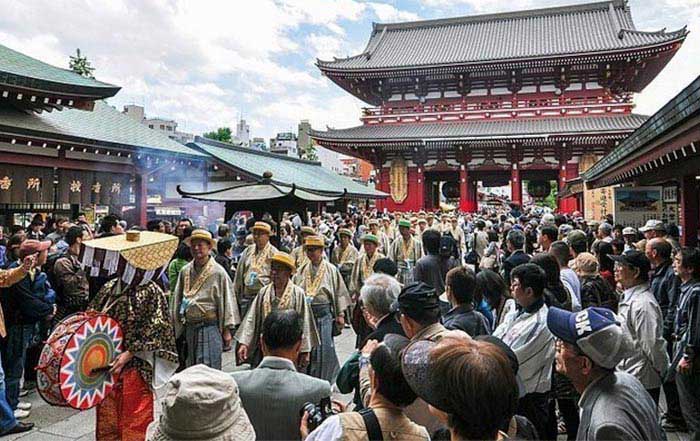Sanja Festival is one of the widest and largest festivals in Tokyo, which takes place every May at Asakusa Shrine and attracts 1.5 to 2 million locals and tourists every year.
The festival is celebrated over the course of three days and features notable parades which revolve around three mikoshi (three portable shrines referenced in the festival’s name), as well as traditional music and dancing.
In the same line of many Japanese festivals, Sanja Matsuri is a religious celebration. This weekend-long Shinto festival is dedicated to the spirits of Hinokuma Hamanari, Hinokuma Takenari and Hajino Nakatomo, the three men who established and founded Senso-ji. Legend tells that two fishermen - brothers named Hinokuma Hamanari and Hinokuma Takenari - found a statuette of the Bodhisattva Kannon caught in a fishing net in the Sumida River on May 17, 628. The third man, a wealthy landlord named Hajino Nakatomo, came to know about the discovery, spoke to the brothers and converted them to Buddhism.
The three men dedicated their lives to the Buddhist faith and sanctified the statue in a small temple. Today, this temple still stands and is known as the Senso-ji, the oldest temple in Tokyo, which is home to the Kannon statue.
The atmosphere around Asakusa during the festival is very lively. People crowd the streets surrounding the Senso-ji while the sound of flutes, whistles, chanting and traditional Japanese drums bring the district to life.
The festival’s main attractions are three Asakusa Shrine-owned mikoshi that make their appearance on the third and final day of the festival. These three intricate black lacquered-wood shrines are conceived to act as miniature versions of Asakusa Shrine. Each mikoshi is decorated with gold sculptures and painted with gold leaf.
Even though the three main mikoshi are the most important objects roaming the streets during the Sanja Matsuri, about 100 other smaller mikoshi are paraded through the neighbourhood on Saturday.

